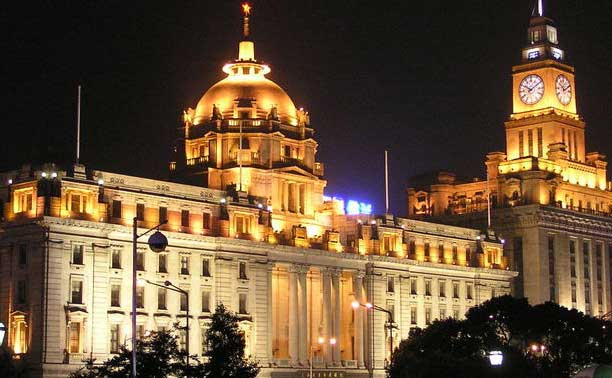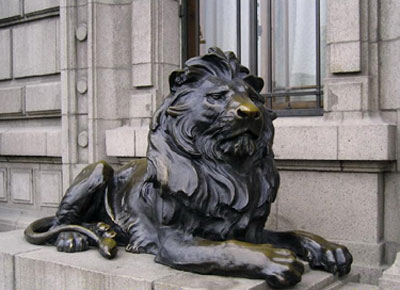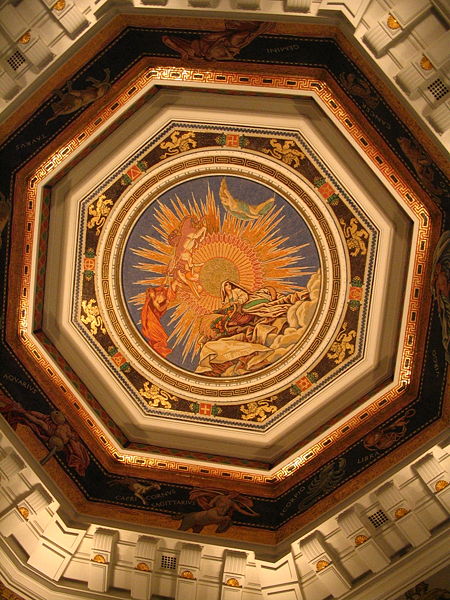
The HSBC Building is a six-floor neo-classical building in the Bund area of Shanghai, China. It was the headquarters of the Shanghai branch of The Hongkong and Shanghai Banking Corporation from 1923 to 1955. The building is situated at number 12, the Bund. It is also known as the Municipal Government Building. Currently it houses the Shanghai Pudong Development Bank.
Construction began on May 5, 1921, and completed in June 23, 1923. This building was built in the style of neo-classicism in China. It was designed by the British architecture firm, Palmer & Turner Architects and Surveyors.
Layout
The HSBC Building has been called "the most luxurious building from the Suez Canal to the Bering Strait". The building has a floor area of 23,415 m2, and was, at the time, the largest bank building in the Far East, and second largest in the world, after the Bank of Scotland building in the United Kingdom.
The building exterior adopted a strict neo-classicist design, with a tripartite vertical and horizontal division. In the centre is a dome, the base decorated with a triangular structure in imitation of Greek temples. Below that are six Ionic columns penetrating from the second to the fourth storey. The main structure is five storeys, the central section seven storeys, with one and a half storey for the basement. The main structure has a steel lattice with brick filling, and a granite exterior.
The interior was luxuriously decorated, using materials such as marble and monel. The whole building was fitted with heating and air-conditioning. The main trading hall has eight columns hewn from whole blocks of marble, which was at the time unique in Asia.
Behind the main building is a subsidiary building which houses bank offices, safes, and vaults.
History
On March 4, 1865, HSBC opened its Shanghai branch on the ground floor of the Central Hotel (now Peace Hotel) on the corner of the Bund with Nanjing Road.
By 1874, HSBC's business had grown so much that the existing premises was becoming cramped. The bank then purchased the Foreign Club, a three storey building at number 12, the Bund, south of the Customs House, for 60,000 taels of silver.
In 1912, the bank made further acquisitions at number 10 and number 11, the Bund, and began construction of the new building. Construction began on May 5, 1921, with the dome capped off on June 23, 1923. According to contemporary press reports, at the time of construction the bank hired feng shui masters to select the time and direction of the first excavation. In accordance with Chinese tradition, coins from around the world were buried in the foundations. Specially minted coins were placed in dark recesses of the building to ward off spirits. The construction took 25 months, and the completed building occupied 1.3 hectares, with an area of 23,415 m2. The architect's firm, Palmer & Turner, also designed numerous other buildings on the Bund including the Yokohama Specie Building, Yangtze Insurance Building, and Bank of China Building.
During the Second World War, the HSBC building was occupied by the Japanese Yokohama Specie Bank. HSBC moved back at the end of the war.
The Communists took over Shanghai in 1949. HSBC continued to operate in the relative freedom of the early years of the People's Republic. However, in 1955 the political situation led the bank to scale down its operations in Shanghai. The building was handed over to the government, and HSBC rented separate offices nearby. Later in that year, the Shanghai Municipal Government moved into the building. The building's name was changed to "The People's Government of the Municipality of Shanghai Building", or "Municipal Government Building" for short. The subsidiary building housed the Municipal Archives from 1956.
In 1990, the Municipal Government began moving civic institutions out of the Bund in favour of commercial institutions. HSBC made contact with the Municipal Government on repurchasing the building, but negotiations failed due to price reasons.
In 1997, the Municipal Government moved out of the building, and the Shanghai Pudong Development Bank obtained the lease to the building. During renovations, spectacular murals were uncovered in the building. HSBC's Chinese office is currently headquartered at HSBC Tower, Shanghai.


Bronze Lions
Out of feng shui considerations, the bank ordered two bronze lions from the United Kingdom at the time
of construction, to be placed outside the front doors. The two lions were named after the Hong Kong branch manager, A.G. Stephen, and the Shanghai branch manager, G.H. Stitt respectively. They were scultped by W.W. Wagstaff and poured by Chou Yin Hsing. In 1935, a copy of these lions were placed in front of the new HSBC building, Hong Kong in Des Voeux Road.
The Japanese occupied Shanghai (International Settlement) and Hong Kong in 1941. In 1943, with a material shortage on their hands, the Japanese decided to transport the two sets of lions to Japan. The Hong Kong lions were transported along with statues of Queen Victoria and the Governor of Hong Kong, Sir Thomas Jackson. They were stored in Yokohama, and discovered by the American occupation force in 1945. The Shanghai lions were sawed off but not removed.
In 1966, with the Cultural Revolution erupting throughout China, the Shanghai Artefact Administration Board moved the lions to be stored in the warehouse of the Shanghai Comedy Troupe. In 1980 they were handed over to the Shanghai Museum. In 1997, when the Pudong Development Bank moved into the building, a copy of the original lions were made and placed in front of the building.

Dome mosaics
Near the ceiling of the octagonal entrance hall of the bank building were originally eight mosaic murals. The dome was decorated with frescos depicting the twelve signs of the zodiac, as well personifications of the Sun and Moon. An enterprising architect had the mosaics covered over in stucco and paint to save them from destruction during the Cultural revolution. Red Guards intent on the mosaics' destruction initially wanted to chip away the mosaics' tiles. The architect suggested it would take less work to just cover them up, knowing full well it would preserve the artwork. In 1997, renovations uncovered them. The Pudong Development Bank then funded the restoration, but changed the HSBC emblems in the paintings to the Pudong Development Bank emblem.
The eight murals depicted eight cities in which HSBC had branches: Shanghai, Hong Kong, Tokyo, London, New York, Bangkok, Paris, and Calcutta. Each fresco featured a principal mythological figure, supported by personifications of local rivers and the city, with city scenery in the background.